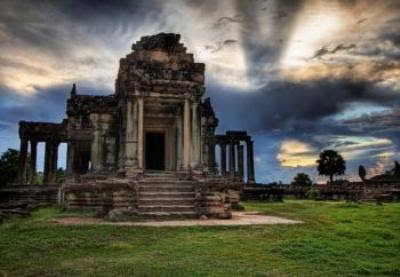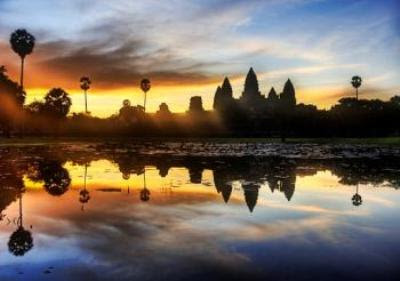The UNESCO-recognised World Heritage Site of Angkor Wat and its surrounding temples are arguably the most important and impressive temple complex in Asia. Built by the powerful Khmer civilization between 802 and 1220 AD the temples represent one of mankind's most astonishing and enduring architectural achievements and it is no surprise when one gazes upon it to learn it was from here that the Khmer kings ruled over a vast empire that stretched from Vietnam to China and across to the Bay of Bengal. This is truly Cambodia’s greatest site.

The period today referred to as the “Angkor Period” stretched from 812AD to 1432AD. During this time the Khmer kings built a city from which they ruled a vast empire, with a capital first at Phnom Kulen, 40km northeast of Angkor, and then around and at the site of what we refer to as Angkor Wat today.
Much of what we see and admire dates from what is known as the Classical Age; Angkor Wat the largest and best preserved temple at the site it was built for King Suryavarman ll in the early 12th century as his state temple and capital city. Everything here is built on a huge scale leaving one to imagine what the area was like when populated by up to a million people, the largest city of its time, their wooden houses eaten away by time and the jungle.

Angkor was to remain ‘lost’, ‘undiscovered’ by Western archaeologists at least, until the late 19th century when the French archaeologist Henri Mouhot came across it in 1868 ands whose prosaic description of the walled city clad in jungle created the image we still have today.
There are countless temples at Angkor but some of the main one of course, is Angkor Wat itself, regarded as the masterpiece of Khmer architecture; the walled city of Angkor Thom; the Baphuon, an 11th century temple with a 131-foot reclining Buddha; the Bayon, famous for its superb bas-reliefs and mysterious faces and Ta Prohm, still cloaked in jungle.

A minimum of two days and preferably 4 are needed to get to grips with the full extent of Angkor Wat. A guide is essential at some point given the 7-century history of the area and to begin to appreciate the achievements of the Khmer civilisation. Entry tickets are available in 1, 3 and 7 day durations (passport photo required for multi-day passes).
Sunrise or sunset at the site is a must, but also good is to head to Ta Phrom where the tree roots of the jungle add to the atmosphere of being in that legendary ‘lost city’.

There are a number of ways to explore, but on foot and by bike are the best. Cyclos too are fun – and easier on the legs in the hot sun. For those that want a bit of a different perspective on the region there are elephant and hot-air balloon rides. Those with deep pockets can even hire a helicopter.

The period today referred to as the “Angkor Period” stretched from 812AD to 1432AD. During this time the Khmer kings built a city from which they ruled a vast empire, with a capital first at Phnom Kulen, 40km northeast of Angkor, and then around and at the site of what we refer to as Angkor Wat today.
Much of what we see and admire dates from what is known as the Classical Age; Angkor Wat the largest and best preserved temple at the site it was built for King Suryavarman ll in the early 12th century as his state temple and capital city. Everything here is built on a huge scale leaving one to imagine what the area was like when populated by up to a million people, the largest city of its time, their wooden houses eaten away by time and the jungle.

Angkor was to remain ‘lost’, ‘undiscovered’ by Western archaeologists at least, until the late 19th century when the French archaeologist Henri Mouhot came across it in 1868 ands whose prosaic description of the walled city clad in jungle created the image we still have today.
There are countless temples at Angkor but some of the main one of course, is Angkor Wat itself, regarded as the masterpiece of Khmer architecture; the walled city of Angkor Thom; the Baphuon, an 11th century temple with a 131-foot reclining Buddha; the Bayon, famous for its superb bas-reliefs and mysterious faces and Ta Prohm, still cloaked in jungle.

A minimum of two days and preferably 4 are needed to get to grips with the full extent of Angkor Wat. A guide is essential at some point given the 7-century history of the area and to begin to appreciate the achievements of the Khmer civilisation. Entry tickets are available in 1, 3 and 7 day durations (passport photo required for multi-day passes).
Sunrise or sunset at the site is a must, but also good is to head to Ta Phrom where the tree roots of the jungle add to the atmosphere of being in that legendary ‘lost city’.

There are a number of ways to explore, but on foot and by bike are the best. Cyclos too are fun – and easier on the legs in the hot sun. For those that want a bit of a different perspective on the region there are elephant and hot-air balloon rides. Those with deep pockets can even hire a helicopter.